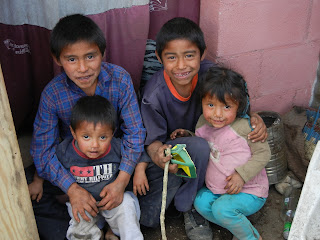Perhaps the highlight of our week was our visit to San Miguel Escobar (a local pueblo) with an NGO called ConstruCASA (http://www.construcasa.org/nuevo/index.php). ConstruCASA is similar to Habitat for Humanity, but focuses primarily on building homes for those in extreme poverty in Guatemala. They work with other local NGOs to identify families that would be a good fit to receive a house (e.g., own their land, are willing to work to pay off a quarter of the $3,000 house over time, and have kids who would benefit from improved living conditions). A member of the family is also required to help build the house with the ContruCASA team so they can understand what goes into the project.
We were able to visit a family that is about to receive a house, and two families that recently got their houses. What we saw was indescribable. Just fifteen to twenty minutes outside of Antigua (one of the most well off cities in Guatemala), people are living in houses made from bamboo rods and corrugated metal. The floors of the house are dirt and often several families share one housing "compound." We visited one owned by a grandmother who said the land has been passed down in her family for generations. She shares the land now with her two daughters who are married and her son, who is still single. She apologized to us because the house wasn't "cleaned up" (mind you, the floor is dirt - even I couldn't keep that clean!) However, she showed a toothless grin and invited us in.
Aaron walking into the grandmother's house, followed by a stream of kids.
Inside a traditional house.
The grandmother talking to Aaron about her chickens.
Her family has 11 kids all very close in age. The kids played in the open air "courtyard" by the outdoor kitchen, using a simple rope for a tug-a-war type game. They were covered in dirt and many were ill from the amount of dust in the air. However, they were all very happy and loved having visitors.
We walked about five steps up the hill to see the new ConstruCASA house that one of her daughters (with five children) received. The whole family used to sleep in one room together on a mattress on the dirt. Now they have two rooms (one for boys and one for girls, she informed us) with cement floors and they even have a shower. The shower is just a cold water spigot in a small cemented area big enough for one person, but the mother described how nice it is to shower alone and in private. The family also has a potable water tap now (foreigners would still have to filter it...). She was also proud to show us her cooking stove, which has proper ventilation to avoid CO2 poisoning that is common in this area when people cook over a fire in an enclosed area.
The view from the new house, looking over the "old" family compound.
One of the kids walking up to his new house with us.
Brothers playing at the clean water spigot.
Kids from the family that received the new house.
Aaron at the build-site of a new house next door.
Walking out of town, some of the kids followed behind us. However, they were quickly called back to help wash clothes and prepare dinner. What a difference a house can make in the happiness and dreams of a family. I think the most important part, however, is teaching the family how to use their new land and leverage their living situation to promote good health - from growing some of their own food, to proper hand washing before preparing meals. This is not something that ConstruCASA works on. We are anxious to observe some of the other charities that ConstruCASA works with to provide this immensely important education. After all, the house does not guarantee a healthy environment and to come out of poverty, the families and children have to be healthy enough to be able to work and go to school. Such a complex equation. We are slowly putting the pieces together and determining where and how we can make a difference with similar communities in Bolivia.
The kids in front of their local "tienda" watching us walk back to the bus.
A proud mother with her kids in front of her house.




































